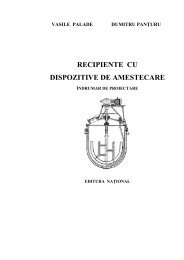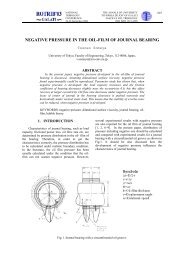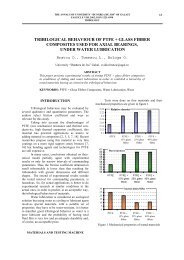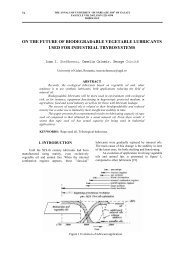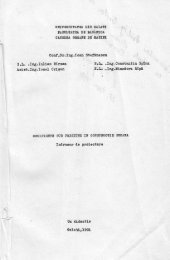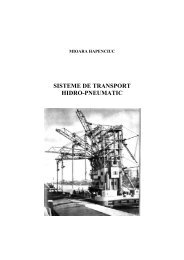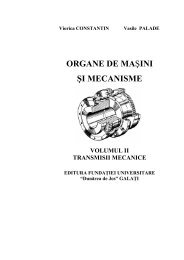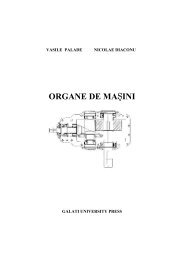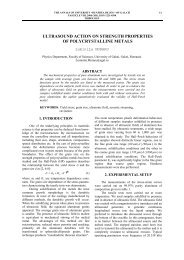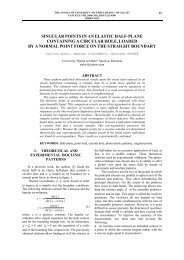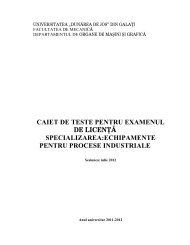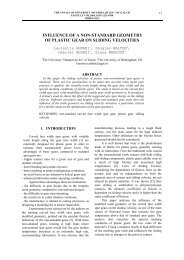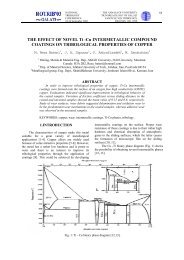flammability test data in risk assessment
flammability test data in risk assessment
flammability test data in risk assessment
You also want an ePaper? Increase the reach of your titles
YUMPU automatically turns print PDFs into web optimized ePapers that Google loves.
72<br />
THE ANNALS OF UNIVERSITY “DUNĂREA DE JOS“ OF GALAŢI<br />
FASCICLE VIII, 2008 (XIV), ISSN 1221-4590<br />
TRIBOLOGY<br />
and the procedure. Even if the <strong>test</strong> is, <strong>in</strong> pr<strong>in</strong>ciple,<br />
simple and the results are quantified <strong>in</strong> only three<br />
possible ways, the procedure was well established <strong>in</strong><br />
order to obta<strong>in</strong> repeatability, a desired characteristic<br />
of the <strong>test</strong> results but hard to obta<strong>in</strong> for <strong>test</strong> <strong>in</strong>volv<strong>in</strong>g<br />
fire or <strong>flammability</strong> characteristics [26]. Discussions<br />
at ISO/TC 28 from 2000 also set the <strong>test</strong> parameters<br />
accuracy, <strong>in</strong> order to give the possibility of rank<strong>in</strong>g<br />
fluids based on a well established procedure. For<br />
<strong>in</strong>stance, there was <strong>in</strong>troduced three temperature<br />
sensors, with imposed position on the manifold (two<br />
on its opposite sides – near the ends of the rod and<br />
one at the center of it), and not one as <strong>in</strong> the first<br />
version of the standard, <strong>in</strong> order to have a better<br />
control of the temperature uniformity that has to be at<br />
all these three po<strong>in</strong>ts with<strong>in</strong> 700°C±5°C (or other<br />
selected temperature, but with same accuracy)<br />
Several specifications are related to the fluid<br />
sample: the temperature, the volume and the state<br />
(<strong>in</strong>clud<strong>in</strong>g the fact that “any air bubbles which may<br />
have arise on mix<strong>in</strong>g shall be allowed to escape from<br />
the fluid before <strong>test</strong><strong>in</strong>g”). It is <strong>in</strong>terest<strong>in</strong>g to notice<br />
that the majority of comments were done by countries<br />
that are big manufac-turers and users of hydraulic<br />
fluids (United K<strong>in</strong>gdom, Canada) [45].<br />
This <strong>in</strong>ternational <strong>test</strong> method and <strong>test</strong>er has the<br />
highest degree of resemblance to the American Hot<br />
Manifold Ignition Test (Federal Test Method 791,<br />
Method 6053.1) [40], the results of the <strong>test</strong> be<strong>in</strong>g also<br />
quantified <strong>in</strong> a similar way (Tab. 2). Even the <strong>test</strong>er<br />
dimensions are very close to those of the <strong>test</strong>er<br />
describes <strong>in</strong> EN ISO 20823:2003.<br />
This ISO <strong>test</strong><strong>in</strong>g method is ma<strong>in</strong>ly used for<br />
assess<strong>in</strong>g the resistance to ignition of the fire-resistant<br />
fluids that are, by def<strong>in</strong>ition, difficult to be ignited.<br />
The procedure given <strong>in</strong> this standard is also specified<br />
<strong>in</strong> ISO 12922-1999, Lubri-cants, <strong>in</strong>dustrial oils and<br />
related products (class L). Family H (hydraulic<br />
systems). Specifications for categories HFAE, HFAS,<br />
HFB, HFC, HFDR and HFDU.<br />
Many specifications related to hydraulic fluids<br />
and oils <strong>in</strong>clude the results of some others <strong>test</strong>s<br />
concern<strong>in</strong>g the fire resistance and <strong>flammability</strong>, the<br />
shear stability and the determ<strong>in</strong>ation of extremepressure<br />
and anti-wear properties, tak<strong>in</strong>g <strong>in</strong>to account<br />
other standards than those <strong>in</strong>volved <strong>in</strong> this study [20,<br />
21, 43]<br />
The FM Standard 6930 [2] was <strong>in</strong>tended to <strong>test</strong><br />
only hydraulic fluids. A sample of the hydraulic fluid<br />
be<strong>in</strong>g <strong>test</strong>ed was pressurized to 6.89MPa and heated<br />
to a fixed temperature start<strong>in</strong>g from 60°C. There were<br />
performed four <strong>test</strong>s: <strong>test</strong> for determ<strong>in</strong><strong>in</strong>g the<br />
chemical heat release rate of the fluid, flame<br />
propagation <strong>test</strong>, <strong>test</strong> for measur<strong>in</strong>g critical heat flux<br />
for ignition, hot surface ignition <strong>test</strong>. The la<strong>test</strong> was<br />
designed to mimic hydraulic fluid leak<strong>in</strong>g under high<br />
pressure from a hose <strong>in</strong> an environment where hot<br />
surfaces are common. Hydraulic fluid was sprayed<br />
from a nozzle onto a steel surface heated to 700°C.<br />
FM will also work with the American Petroleum<br />
Institute to <strong>in</strong>clude the new specification <strong>test</strong><br />
standard with<strong>in</strong> a new hydraulic fluid <strong>flammability</strong><br />
standard be<strong>in</strong>g developed by the International<br />
Organization for Standardization (ISO) [34].<br />
The objectives of the grant CEEX-M4-452<br />
<strong>in</strong>cludes applicative research concern<strong>in</strong>g the three<br />
<strong>test</strong><strong>in</strong>g methods that now are not performed <strong>in</strong> our<br />
country for technical fluid <strong>assessment</strong> conformity by<br />
tak<strong>in</strong>g <strong>in</strong>to account the requirements of the European<br />
directives [6-9, 14]. As far as the authors could have<br />
<strong>in</strong>vestigated, the <strong>test</strong> <strong>in</strong>cluded <strong>in</strong> SR EN ISO<br />
20823:2004 has not been not performed <strong>in</strong> Romania<br />
till nowadays. This affirmation is based on the<br />
negative answers received from 10 laboratories<br />
hav<strong>in</strong>g RENAR (Asociatia de Acreditare d<strong>in</strong><br />
Romania, Romanian Accreditation Association)<br />
accreditation for analys<strong>in</strong>g, <strong>test</strong><strong>in</strong>g and research on<br />
fuels, oils, lubricants. These laboratories confirm that<br />
they can not perform any one of the three <strong>test</strong>s under<br />
the requirements of the European standards, as imposed<br />
by the Directive 92/104 [7]. These laboratories<br />
are: ICERP SA Ploieşti, ICMET Craiova, INCERP -<br />
CERCETARE SA Ploieşti, LAREX CNIEP - Centrul<br />
Naţional pentru Încercarea si Expertizarea Produselor,<br />
ROMPETROL QUALITY CONTROL SRL,<br />
PETROTEL LUKOIL SA Ploieşti, RULMENTUL<br />
SA, PETROM SA (ARPECHIM).<br />
Some laboratories expla<strong>in</strong> the reasons why they<br />
could not do these <strong>test</strong>s, especially the absence of the<br />
necessary equipment and some of them could do one<br />
or two of these <strong>test</strong>s but <strong>in</strong> accordance to other<br />
standards. For <strong>in</strong>stance, Total Lubrif<strong>in</strong> SA can<br />
perform two of the above-mentioned <strong>test</strong>s but<br />
follow<strong>in</strong>g the requirements of ASTM standards.<br />
4. THE TESTER<br />
The <strong>test</strong>er design meets the requirements<br />
imposed by SR EN ISO 20823:2004, compris<strong>in</strong>g (fig.<br />
2) a robotic system 1 that automatically ensures the<br />
position<strong>in</strong>g of the fluid dispenser 5 above the<br />
simulated manifold, at a position desired by the<br />
operator, with<strong>in</strong> a high temperature enclosure 4. The<br />
manifold is made of corrosion resistant steel and it<br />
could be heated by an electric system up to 700°C.<br />
The temperature control is done by the help of three<br />
digital thermocouples mounted on a transversal<br />
guid<strong>in</strong>g system 3 that allow them to be <strong>in</strong> contact<br />
with the manifold and then withdrawn dur<strong>in</strong>g the<br />
fluid dropp<strong>in</strong>g. All the above mentioned subsystems<br />
are enclosed <strong>in</strong> the ventilated enclosure 2.<br />
5. PRELIMINARY RESULTS<br />
Table 3 presents three <strong>test</strong>s done at elevated<br />
temperature and <strong>in</strong> the last column there are presented<br />
comments that could give supplementary<br />
characteristics of the <strong>test</strong>ed fluids. For <strong>in</strong>stance, a



